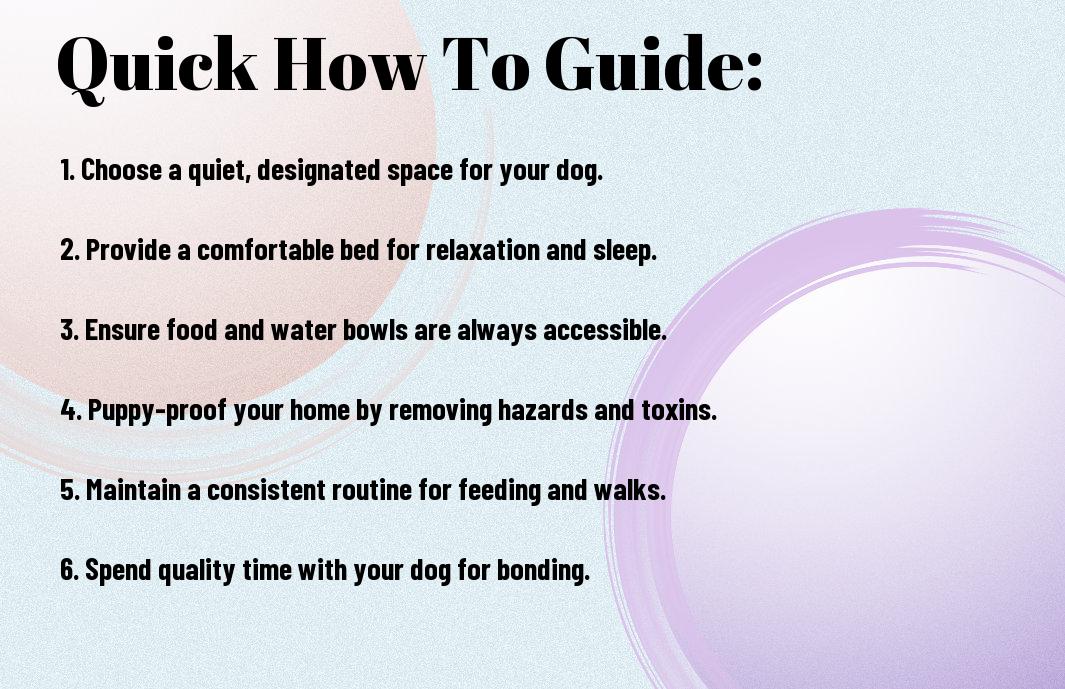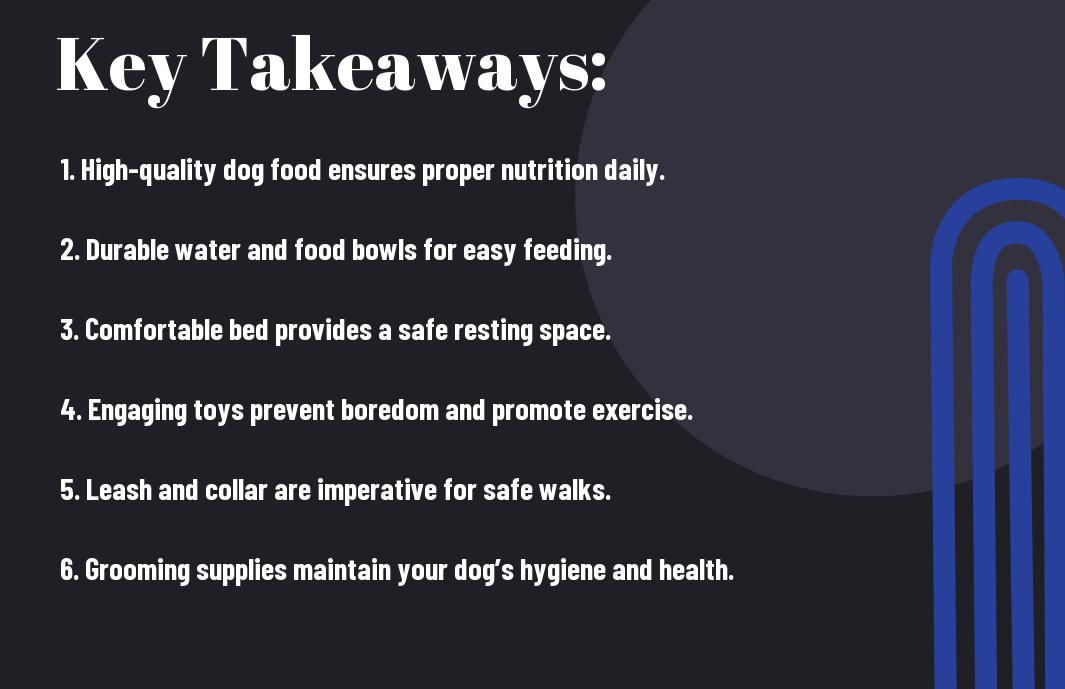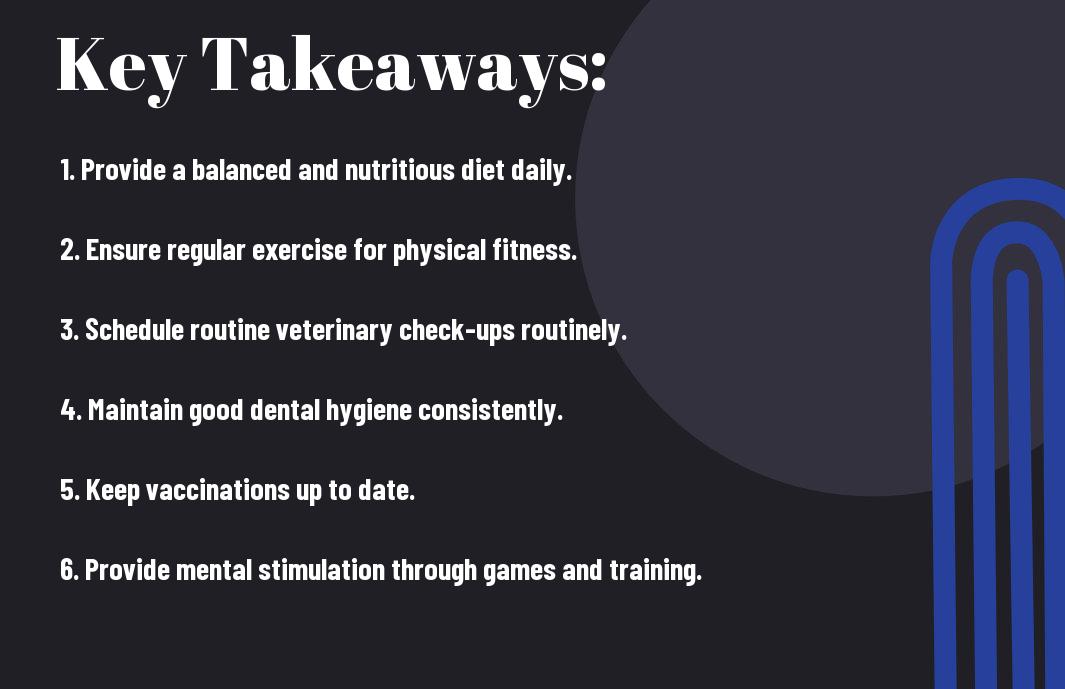Most dog owners want to ensure their furry friends feel secure and at home. It’s crucial to create an environment that promotes both safety and comfort for your canine companion. In this guide, you’ll learn practical steps to set up your living space, select the right materials, and establish routines that cater to your dog’s needs. By making these adjustments, you can enhance your dog’s overall well-being and strengthen the bond you share.

Understanding Your Dog’s Needs
While every dog has unique preferences, understanding your dog’s fundamental needs is vital for creating a safe and comfortable environment. This involves recognizing how different factors can influence their overall sense of security and well-being. Each dog is an individual, influenced by factors such as breed, age, health, and past experiences. Understanding these elements can help you tailor your living space to better suit your furry friend.
Factors That Influence Comfort
Assuming you want to optimize your dog’s comfort, there are several key factors to consider. Environmental aspects, such as noise levels, temperature, and space layout, play a significant role in your dog’s happiness. Additionally, their social needs—like companionship and interaction—also affect their state of mind. When creating a comfortable environment, consider the following:
- Noise levels in your home
- Temperature variations
- Access to safe outdoor spaces
- Availability of personal space for rest
- Social interaction opportunities
Any one of these factors can significantly impact how secure your dog feels in their environment. By addressing these considerations, you can create a sanctuary that meets your dog’s distinct needs.
Behavioral Characteristics
Behavioral characteristics also play a vital role in understanding your dog’s needs. Each dog has its own personality traits, such as sociability, energy levels, and sensitivity, which can affect their comfort in various environments. By observing how your dog reacts to different situations, you can tailor your home to align with their behavioral tendencies. For example, a shy dog may need a quiet, secluded area, while an energetic dog may thrive in a space where they can play and explore.
Another important aspect to consider is your dog’s response to stress or anxiety-inducing situations. Dogs that are easily startled or anxious may require a secure space away from potential triggers. Observing their behavior during these moments can help you identify key areas where you need to improve their environment to ensure they feel safe and comfortable.
Creating a Safe Physical Space
Many dog owners often overlook the importance of creating a safe physical space for their pets. A well-organized environment not only protects your dog but also enhances their overall quality of life. By taking the time to assess your home and make necessary adjustments, you can provide a secure haven for your furry friend. This will allow them to thrive, explore, and engage in their natural behaviors without the risk of injury or stress.
Dog-Proofing Your Home
Any living space has potential hazards that can put your dog at risk. From accessible electrical cords to toxic plants and harmful household cleaners, it’s your responsibility to identify and remove these dangers. Start by conducting a thorough walkthrough of your home, paying special attention to areas where your dog spends the most time. Make sure to store hazardous materials in cabinets out of reach or use childproof locks to keep them secure. Also, keeping small objects that can be swallowed off the floor will prevent choking incidents.
Additionally, you should consider the layout of your living space. Ensure that furniture is arranged in a way that prevents your dog from getting stuck or entangled. Safety gates can help restrict access to areas that may pose a risk, such as staircases or rooms with delicate items. By effectively dog-proofing your home, you create a safer environment where your dog can play and relax without worry.
Designated Areas for Your Dog
If you’re aiming to create a comfortable setting for your dog, consider establishing designated areas just for them. These areas can serve as a retreat where your dog feels secure and can chill when they need a break from the hustle and bustle of daily life. Choose spots that are quiet and away from high-traffic areas, allowing your dog to enjoy their own space. Providing a cozy dog bed, some toys, and even a water bowl will make these areas inviting and functional.
Identifying these special spaces in your home is important to addressing your dog’s needs. Think about incorporating elements like a crate or a specific corner in the living room as their personal area. Designating a spot will not only help with training but also reassure them that they have a safe place to go when they feel overwhelmed or anxious. By fostering a consistent environment where your dog knows they belong, you promote a sense of security and comfort in their lives.
Environmental Factors Impacting Comfort
Your dog’s comfort is influenced by a variety of environmental factors. From temperature and noise levels to the physical space they inhabit, each component plays a significant role in their overall well-being. Understanding these factors allows you to create a safe haven for your furry companion. Here are some aspects to consider:
- Temperature control
- Noise levels
- Space availability
- Lighting conditions
- Air quality
Perceiving these elements helps ensure that your dog feels safe, comfortable, and happy in their environment.
Temperature Control
There’s no denying that temperature significantly affects your dog’s comfort. It’s necessary to keep your home at a temperature suitable for your pet, as dogs can be sensitive to extreme heat and cold. While some breeds have thicker coats that offer them more protection, others may require a little extra care when the temperatures fluctuate. Knowing your dog’s preferences and tolerances can help you make informed decisions about climate control in your living space.
Temperature Considerations for Dogs
| Temperature | Considerations |
|---|---|
| Below 32°F (0°C) | Short-haired breeds may need extra layers or heated areas. |
| 32°F – 75°F (0°C – 24°C) | Most dogs will feel comfortable; monitor for signs of discomfort. |
| Above 75°F (24°C) | Provide fresh water, shade, and air conditioning if necessary. |
Taking an active role in temperature management not only promotes comfort but also prevents potential health issues related to extreme weather conditions.
Noise and Disturbance Management
Any sudden loud noises can startle your dog, leading to stress and anxiety. Factors like thunder, fireworks, or even the sound of bustling household activities can affect your pet’s ability to relax. It’s necessary to create a quiet space or retreat where your dog can feel safe and undisturbed. Utilizing soundproofing methods, such as heavy curtains or wall coverings, can help mitigate unwanted noise, creating a peaceful environment for your pet.
Impacting your dog’s comfort level also includes anticipating their reactions to everyday disturbances. If your pet is sensitive to noise, consider using calming music or white noise machines to mask sudden sounds. Additionally, training them to associate negative noise with positive experiences can help reduce their fear and anxiety. A little effort goes a long way in fostering a harmonious atmosphere for your dog.

Comfort Through Bedding and Accessories
Once again, prioritizing your dog’s comfort is a significant part of creating a safe and enjoyable environment. A well-chosen bed and the right accessories will not only enhance your dog’s quality of life, but they can also help reduce anxiety and promote restful sleep. The perfect bedding will cater to your dog’s size, breed, and sleeping habits, ensuring that they feel secure and cozy at all times.
Choosing the Right Dog Bed
One important aspect of your dog’s comfort is selecting the right bed. Consider their size and sleeping style—some dogs prefer to stretch out, while others like to curl up. Options range from plush pillow beds for dogs that enjoy sprawling to bolster beds that offer a sense of security. Materials also vary; memory foam is excellent for older dogs needing extra joint support, while breathable fabrics keep younger pups cool.
When choosing a dog bed, pay attention to the ease of cleaning as well. Look for removable, washable covers and durable materials that can withstand your dog’s activity. It’s worth investing in a high-quality bed, as this will not only meet your dog’s comfort needs but will also last longer, ensuring they have a designated cozy spot to retreat to over the years.
Additional Comfort Accessories
Accessories are another way to enhance your dog’s comfort beyond just bedding. Items like calming blankets, orthopedic mats, and even heated beds can all contribute to an inviting atmosphere for your pet. You might also consider dog-safe pillows that provide extra head support and plush toys for mental stimulation and comfort, giving your dog a sense of companionship while they rest.
This focus on comfort does not stop at just bedding; think about incorporating items that resonate with your dog’s senses. A calming diffuser can help create a soothing environment, while chew toys made from soft materials can keep your dog engaged and happy. By integrating these additional comfort accessories, you can create a personalized space that caters not just to their physical needs, but also their mental and emotional wellbeing. Your dog deserves a nurturing environment, and these thoughtful additions can make a significant difference in their daily life.
Nutrition and Well-Being
After creating a safe and comfortable home environment for your dog, it’s time to focus on their nutrition and overall well-being. A well-nourished dog is not only healthier but also often happier, leading to a better quality of life. Ensuring that your furry friend receives the right nutrients is key to maintaining their vitality and longevity, so consider their dietary needs carefully.
Providing a Balanced Diet
For your dog to thrive, you need to provide a balanced diet that meets their specific needs based on their age, breed, and activity levels. This typically includes a mix of proteins, carbohydrates, fats, vitamins, and minerals. High-quality commercial dog foods are formulated to deliver these vital nutrients, but it’s always a good idea to consult with your veterinarian to select the best food for your pup. Homemade diets can also be an option, but they require careful planning to ensure they contain all necessary nutrients.
For dogs with specific health concerns or dietary restrictions, choosing the right food becomes even more important. Always read labels to check for meat sources, whole grains, and the absence of fillers or artificial additives. You may also consider supplementing their diet with fresh fruits and vegetables that are dog-friendly, which can add variety and additional nutrients to their daily meals.
Hydration Importance
Snacks and treats play an important role in your dog’s diet, but hydration should never be overlooked. Access to clean and fresh water is vital for your dog’s health. Like humans, dogs are at risk of dehydration, especially after physical activity or in warmer weather. Regularly checking and refilling their water bowl will encourage them to drink enough throughout the day. Always be mindful of their preference for temperature, as some dogs may prefer cooler or room-temperature water.
It’s important to monitor your dog’s water intake, as decreased consumption can be a sign of health issues. Proper hydration aids in digestion, nutrient absorption, and temperature regulation. By fostering healthy drinking habits and ensuring constant access to fresh water, you’re supporting your dog’s overall well-being and maintaining their comfort at home.

Routine and Structure
Unlike many other pets, dogs thrive on routine and structure. Establishing a consistent daily schedule not only helps them feel secure but also fosters good behavior and reduces anxiety. Your dog approaches daily life with a sense of predictability, enabling them to know what to expect and when to expect it. By providing a structured environment, you can create a space where your dog can relax and feel comfortable, knowing that their needs will be met systematically.
Establishing a Daily Schedule
To create a safe and comfortable environment for your dog, it is beneficial to establish a daily routine that includes feeding, exercise, walks, and playtime. By consistently feeding your dog at the same times each day, you help them learn when to anticipate their meals, reducing any related anxiety around hunger. Similarly, scheduling regular walks and outdoor play can give your dog a clear understanding of when it’s time for exercise and socialization, contributing to their overall well-being.
Incorporating training sessions into your dog’s daily routine can also be advantageous. By setting aside time for training activities, whether it’s teaching new commands, working on leash manners, or socializing with other pets, you stimulate your dog’s mind and reinforce positive behaviors. This not only provides structure but also deepens the bond between you and your furry friend, creating a more harmonious living environment.
Recognizing Signs of Stress
Schedule regular check-ins to assess your dog’s emotional state. Being attentive to their body language can provide insight into how they are feeling throughout the day. Signs of stress can manifest in various ways, including excessive barking, panting, or hiding. By being aware of these signals, you can take proactive steps to ease their discomfort, such as providing a quiet space for them to retreat or engaging them in calming activities like gentle petting or soothing background music.
The key to alleviating your dog’s stress is to observe and respond to their needs promptly. If you notice signs of anxiety, such as cowering, tail tucking, or excessive chewing, consider adjusting their environment or routine. Creating a safe haven, equipped with their favorite toys and a cozy bed, can provide a retreat for your dog when they feel overwhelmed. Understanding these cues helps you ensure that your dog’s environment remains a positive and comforting space.
Summing up
As a reminder, creating a safe and comfortable environment for your dog is crucial for their overall well-being and happiness. You should prioritize aspects such as a secure living space, appropriate bedding, and safe toys to ensure your dog feels at home. Regularly evaluate your surroundings for potential hazards and make necessary adjustments to keep your furry friend safe. Additionally, it’s beneficial to establish a routine that includes playtime, exercise, and training, leading to a more balanced and content life for your dog.
Ultimately, the environment you create reflects your commitment to your dog’s health and happiness. By being attentive to their needs and making thoughtful choices regarding their surroundings, you can establish a stress-free atmosphere that nurtures their physical and mental well-being. Take the time to understand your dog’s preferences and behaviors, allowing you to tailor the environment to suit their unique personality. This effort will undoubtedly strengthen the bond you share with your beloved pet.
FAQ
Q: What are the crucial components of a safe environment for my dog?
A: Creating a safe environment for your dog involves several key components. First, ensure that your home is free from hazards such as toxic plants, small objects that could be swallowed, and chemicals like cleaning products and antifreeze. Use baby gates to restrict access to unsafe areas, like staircases or rooms with fragile items. Providing a designated space, like a cozy dog bed or crate, can help your dog feel secure and established. Additionally, make sure all fences and gates are secure to prevent any escapes. Regular checks on these areas will help maintain a safe living space.
Q: How can I make my dog’s living area more comfortable?
A: To enhance your dog’s comfort, focus on providing a clean, quiet, and cozy space. Invest in a quality dog bed that suits your dog’s size and sleeping habits, and place it in a low-traffic area where they can relax undisturbed. Keep their space clean by regularly washing bedding and toys. Gradually introduce calming elements such as soft lighting or soothing music, which can help create a serene atmosphere. Furthermore, ensure that the area is well-ventilated and at a comfortable temperature to suit your dog’s needs.
Q: Are there specific safety measures I should take when traveling with my dog?
A: Yes, taking safety precautions while traveling with your dog is important to ensure their comfort and security. Always secure your dog in a crate or with a seatbelt harness when in a vehicle to prevent distractions and protect them in case of an accident. Bring along their favorite toys, blankets, and water for familiarity during travel. Stop frequently to allow your dog to stretch, relieve themselves, and hydrate. If you’re traveling by air, check the airline’s pet policies in advance and ensure that your dog is crate-trained for safe transport. Prioritize their wellbeing to make the journey enjoyable for both of you.










